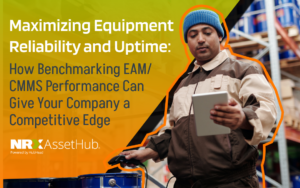Effective management of enterprise assets is crucial for maximizing operational efficiency and driving sustainable growth. However, the costs associated with asset management can significantly impact an organization’s bottom line. To ensure financial sustainability, organizations need to benchmark their EAM costs against industry standards and identify strategies for optimizing asset management expenses. In this blog, we will explore key strategies for benchmarking EAM costs and implementing cost-saving measures.

Establish a Baseline for EAM Costs
Before embarking on cost optimization, it’s essential to establish a baseline for EAM costs. Analyze historical data and categorize expenses related to asset acquisition, maintenance, repairs, and replacements. This baseline will serve as a reference point for future comparisons and help identify areas where costs can be reduced.
Select Appropriate Cost Metrics
Selecting the right cost metrics is crucial for meaningful benchmarking. Some commonly used metrics include:
- Total Cost of Ownership (TCO): This metric calculates the overall cost of an asset throughout its lifecycle, including acquisition, operation, maintenance, and disposal. TCO provides a holistic view of asset costs and enables comparisons across industries.
- Maintenance Cost Ratio (MCR): MCR measures maintenance expenses as a percentage of the asset’s replacement value. It helps evaluate the efficiency of maintenance practices and identify potential areas for cost reduction.
- Mean Time Between Failures (MTBF) and Mean Time to Repair (MTTR): These metrics assess asset reliability and maintenance efficiency. By reducing MTTR and increasing MTBF, organizations can minimize downtime, thereby lowering associated costs.
Compare Against Industry Benchmarks
Benchmarking EAM costs against industry standards and best practices is essential to identify areas where cost-saving opportunities exist. Engage with industry associations, attend conferences, and participate in forums to gain insights into industry benchmarks. Comparing your organization’s costs against peers will help identify areas where your expenses are above average, indicating potential inefficiencies.
Analyze Maintenance Strategies
Maintenance costs often form a significant portion of EAM expenses. Analyze your maintenance strategies to identify areas where cost-saving measures can be implemented:
- Preventive Maintenance: Evaluate the effectiveness of preventive maintenance programs. Are maintenance activities scheduled optimally? Assess the frequency and necessity of maintenance tasks to avoid unnecessary costs.
- Predictive Maintenance: Implement predictive maintenance technologies to detect asset failures in advance. By identifying potential issues early on, organizations can reduce reactive maintenance costs and prevent costly breakdowns.
- Spare Parts Management: Optimize inventory management of spare parts by identifying critical assets and prioritizing their spare parts availability. Implement just-in-time inventory strategies to avoid excess stock and associated holding costs.
Leverage Technology Solutions
Leverage technology solutions to streamline asset management processes and reduce costs:
- Computerized Maintenance Management Systems (CMMS): Implement a CMMS to track maintenance activities, schedule tasks, and monitor asset performance. A CMMS can enhance maintenance planning, optimize resource allocation, and reduce unnecessary expenses.
- Internet of Things (IoT): Utilize IoT-enabled sensors to collect real-time data on asset health and performance. This data-driven approach allows for proactive maintenance, minimizing downtime and associated costs.
Continuous Improvement and Training
Promote a culture of continuous improvement and invest in employee training:
- Performance Monitoring: Regularly monitor key performance indicators (KPIs) to identify deviations from benchmarks and take corrective actions promptly.
- Training and Skill Development: Equip maintenance teams with the necessary skills and knowledge to optimize asset management. Continuous training ensures they stay updated with emerging technologies and best practices.

Benchmarking EAM costs and implementing strategies to optimize asset management expenses is crucial for organizations aiming to improve operational efficiency and financial sustainability.
Looking to Benchmark your EAM?
HubHead’s benchmarking service can provide valuable support. Our experienced consultants have helped numerous companies achieve excellence through comprehensive benchmarking analysis that leverages various benchmark types.
Contact us today by following the links below to download our brochure or book a meeting with one of our consultants.

Maximizing Equipment Reliability and Uptime: How Benchmarking EAM/CMMS Performance Can Give Your Company a Competitive Edge
Working Smarter, Not Harder: Strategies for Improving EAM/CMMS Performance Based on Benchmarking Results
Revamping Maintenance Processes: How Benchmarking Boosts Efficiency
Share this article




